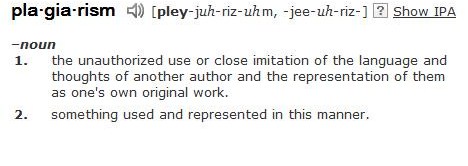
Definition of plagiarism from Dictionary.com (Credit: Dictionary.com)
Does the next generation of bloggers and journalists understand the meaning of plagiarism? A recent New York Times report suggests otherwise.
The article, by Trip Gabriel, looked at three plagiarism cases at the university level at Rhode Island College, De Paul University and University of Maryland — all three where students copied paragraphs or information from the Internet but didn’t source or credit the information.
Those three cases are represenatative of plagiarism these days, and “suggest that many students simply do not grasp that using words they did not write is a serious misdeed,” Gabriel wrote.
Gabriel attributed the misunderstanding and rise in plagiarism largely to the Internet –both the ease of copy and pasting and the lack of understanding what intellectual property, copyright, and authorship. The current generation of students “came of age with music file-sharing, Wikipedia and Web-linking,” and therefore don’t realize the divide between their own material and material on the Internet.
Citing Donald McCabe’s studies from 2006 to 2010, Gabriel reported that about 40% of 14,000 surveyed undergraduate students fessed up to “copying a few sentences in written assignments.” McCabe, a Rutgers business professor, also co-founded the Center for Academic Integrity. In an e-mail to StinkyJournalism, McCabe wrote that the studies Gabriel referred to are just “the latest four years of data in an ongoing project.” His research started in 1990, and this, “the last phase” started in 2002.
McCabe wrote to iMediaEthics that he started his research because he wanted to learn more if honor codes still meant anything.
“I went to an undergrad institution with an honor code and I started this project to see if honor codes still made a difference to students in the 1990s. (I graduated in 1966.) I am pleased to report they still made a difference although that difference seems to be eroding somewhat over the years,” McCabe wrote.
However, Gabriel ended his report noting that most of the 196 plagiarism cases at University of California, Davis, last year weren’t because students didn’t know plagiariasm was wrong or didn’t know that they were plagiarism. Rather, the students knew they were plagiarizing and just didn’t want to write.
That ending seemingly counters Gabriel’s entire aritcle, which claims that the current student generation doesn’t understand what plagiarism is. Mother Jones’ writer Kevin Drum criticized Gabriel’s article, suggesting that the real story is that “digital technology makes copying and pasting easy.” The Internet, Drum wrote, just makes it easier for people to find what they need and copy it to their reports.
He also called out The Times for ending its article with the contradictory information that University of California, Davis students knew what cheating was but still did it.
How can students be best educated on what plagiarism is and how to not plagiarize? McCabe wrote in response to an e-mail from iMediaEthics that perhaps the educators themselves aren’t as concerned with fighting plagiarism anymore.
“This question has no simple answers and I have no simple elixirs,” McCabe wrote. “At the most basic level, I am concerned that many faculty have or are giving up on this issue – making it worse overall. My view is that any solution will only be effective when we et al the relevant constituents involved in a dialogue – students, teachers, and parents as well as administrators – not just at the college level but secondary and elementary schools as well.”
The Volokh Conspiracy’s Jonathan Adler wrote about Gabriel’s article, wondering if perhaps students just aren’t properly taught the importance of attribution and the costs of cheating. (The Volokh Conspiracy is a group blog mostly made up of law professors, its site explains.) “The problem is not that academic standards are too strict for the Internet Age. Rather, it’s that students are not taught that such standards really matter,” Gabriel wrote.
A commenter on Adler’s story, “anon321,” suggested that perhaps plagiarism is documented more because we have better detection systems. Likewise, The Digital Journal’s Paul Wallis noted that “plagiarism isn’t even a working business any more” thanks to search engines, content protection lawyers and plagiarism detection services like CopyScape.
Outside of a simple online search — Googling a few sentences or phrases will often turn up any other instances of that text online, for example — schools can use services like Plagiarism Detect and Turnitin to scan work for possible plagiarism.
Wallis opined that plagiarism is “professional suicide for writers.”
The Times article is part of a series on plagiarism in schools. For example, in July, The Times reported how colleges have been studying plagiarists to learn their strategies. See other articles in the series here.
As you may remember, The New York Times was rocked with its own plagiarism scandal several yearas ago. Times reporter Jayson Blair resigned in 2003 after being caught making up comments and scenes, and plagiarizing from other news sources.
Blair isn’t the only Times journalist accused of plagiarism. As recently as February of this year, New York Times reporter Zachery Kouwe resigned after being accused of plagiarism. The Wall Street Journal claimed Kouwe copied part of one its articles.






Comments Terms and Conditions